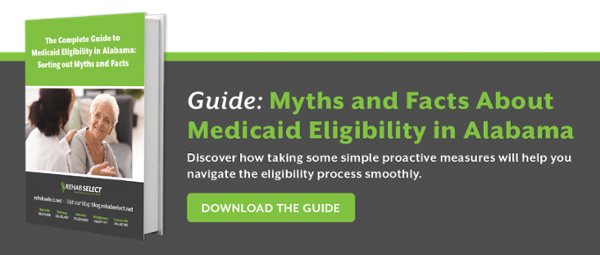This is the second of a four-part series exploring how to navigate the complex landscape of Medicaid eligibility with success.

Property ownership is a nuanced and complicated aspect of Medicaid eligibility. One of the most common questions Medicaid applicants have is whether the recipient can own significant property and still qualify for Medicaid. One common misconception is that Medicaid will take ownership of the recipient’s property through the lien it places.
We talked to Rehab Select’s resident Medicaid expert Karen Golson to understand Medicaid’s rules regarding property ownership and dispel common misconceptions. It’s important to know that Medicaid allows for significant real estate assets in determining eligibility, and recipients are not signing over ownership of their property to Medicaid.
Use this guide to better understand the rules of property ownership for Medicaid and how these guidelines affect the recipient and their families for long-term financial planning.
What Qualifies as Property
First, what qualifies as real estate? Golson says that real estate is “dirt and anything that sits on the dirt,” including anything attached to the property, such as a mobile home. The applicant may have various properties accumulated throughout his or her lifetime—and possibly even hold some deeds to long-forgotten properties that their children know nothing about. Rest assured that the Medicaid agency will do its own check and inform the applicant of any obscure properties they own.
Medicaid won’t count every property the applicant owns in its calculation of assets. These are called property exclusions. Medicaid always will exclude one piece of property as a residence. No matter how much that property is worth, Medicaid will not count it as an asset when determining eligibility. Aside from the first property, Medicaid applicants may have other properties such as vacation homes or timeshares that would not be excluded.
However, another important property exclusion is activated if the person’s spouse or dependent child still lives in the home. Typically, the dependent child (in this case) would be a disabled child, since most elderly applicants will not have minor children. If another family member such as a brother or sister is a joint owner of the property, it can be excluded as well.
Interestingly, the applicant can put a property up for sale in order to have it excluded. The property doesn’t have to sell during the time of the application but needs to be continuously listed in order to be excluded. When the property does sell, it needs to sell for the full market value. That simply ensures it will not be sold to children or relatives of the Medicaid applicant for a below-market price just to take the property out of their hands.
Sorting Out Confusion about the Property Lien
Medicaid places a lien on the recipient’s properties when they start receiving benefits. There is usually some confusion for applicants about the property lien and exactly what it does. A lien is a claim against a specific piece of property. The lien must be settled when a property is sold or the title is transferred. A property lien does not mean that Medicaid now owns the property.
Golson explains that there is a common apprehension among Medicaid applicants and their families that “Medicaid is going to take Grandma’s house.” Families are especially sentimental about a home that may have been in the family for generations. “Grandma’s house” is a source of pride for the family. It might be the first house that family bought and paid for and the place to stay if anyone is ever in need. Or perhaps Grandma may have made the family promise to never sell the house.
Let’s be clear. “Medicaid never takes ownership of anyone’s property,” Golson says. When Medicaid places a lien on the property, it is a way to potentially recoup some of the costs associated with providing benefits. However, there are more nuances to this claim that meets the eye—and that’s good news for many Medicaid recipients.
The property lien protects the Medicaid recipient as well. It prevents anyone from changing ownership of the property or refinancing the property while the recipient is in the nursing home without notifying Medicaid. If anyone tries to sell the property, they must notify Medicaid for the legal action to proceed. Because Medicaid is excluding the asset, they want to ensure that no one takes it from you without the resident benefiting from it. “The lien protects the recipient against anything underhanded that may occur,” Golson says. “It could be people borrowing or stealing the property.”
The property lien must be settled at some point for Medicaid to recoup some of the costs of providing benefits. For many recipients, the amount that Medicaid recoups from the property is only a fraction of what Medicaid paid out to the recipient in benefits. Very few people have property valuable enough to pay Medicaid in full. Mortgages and other costs associated with the sale of property, such as closing costs take precedence over the Medicaid lien, meaning these obligations will be paid first before anything is paid out to Medicaid.
The settlement will never be more than the value of the property itself. It will also never be more than the benefits that Medicaid paid out to the recipient. For example, if the property was only worth $200,000 and Medicaid paid out $250,000 in benefits, Medicaid will not be able to recoup more than the value of the property. If the property was worth $200,000 and Medicaid paid out only $10,000 in benefits, Medicaid will only be able to recoup a maximum of $10,000 from the settlement.
Here are various scenarios of how the lien could be settled:
- If the recipient goes into the nursing home but later returns to live at their home, the property lien will be taken away.
- If the recipient passes away, the property may be inherited by children. The lien will still be on the property, and it’s up to the inheritors to settle the lien.
- The owners of the property could live in the house for 20 years and never contact Medicaid to settle the lien. The title would not be cleared, but the owners would not have to make any payments either during that time.
- They could settle the lien immediately or through a payment process. Once the payments are complete, the property lien would be removed.
- They could sell the property and settle the lien, potentially with the proceeds from the sale.
Golson advises Medicaid applicants to complete these steps carefully during the application process as it pertains to property ownership.
1. Read the lien carefully before signing.
2. Make sure the legal description of the property is correct.
3. The document has to be notarized.
4. The document has to bear the state seal.
5. The property lien has to be signed by the client.
6. If the client can’t enter into the agreement, someone with the power of attorney or a court-appointed conservator has to sign it.
7. The client must have ready access to a copy of the deed, which must have the client’s name on it.
8. Medicaid benefits can’t be awarded until the property lien agreement is signed.
Get Help with Medicaid Eligibility
This guide on property ownership should help you gain more clarity about property concerns and the Medicaid application process. However, it’s often best to get expert counsel when applying for benefits. We understand that applying for Medicaid eligibility is inherently complex, so planning is critical to making the process as easy as possible for you and your family members. To learn more about how Rehab Select’s resident Medicaid expert can help you sort out the details, contact us here. Navigating Medicaid eligibility doesn’t have to be overwhelming — we are here to guide you through the steps.




